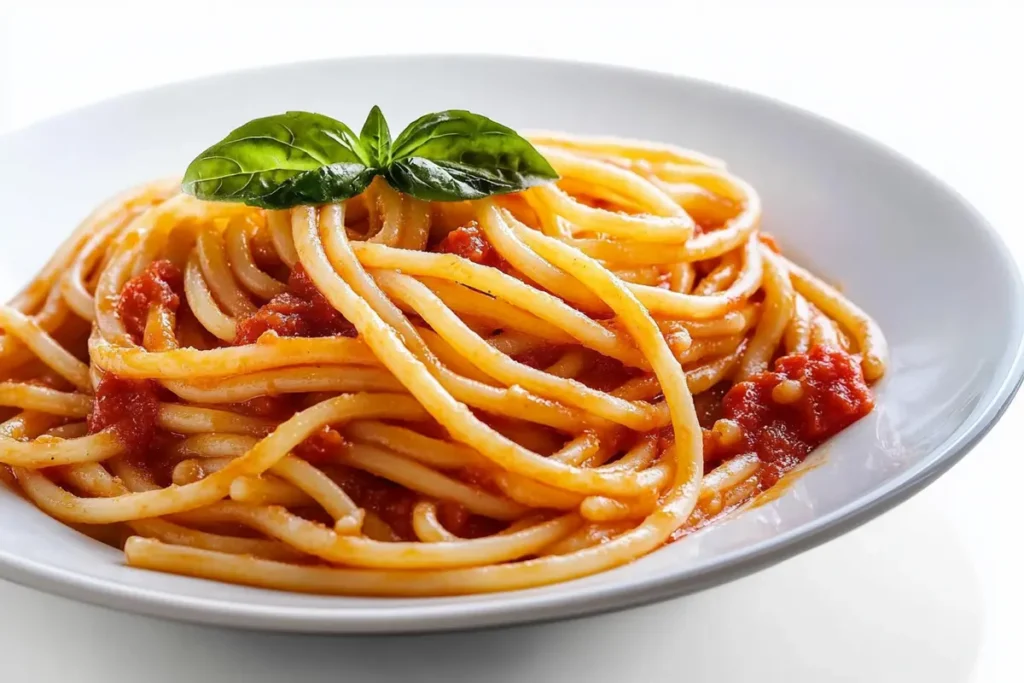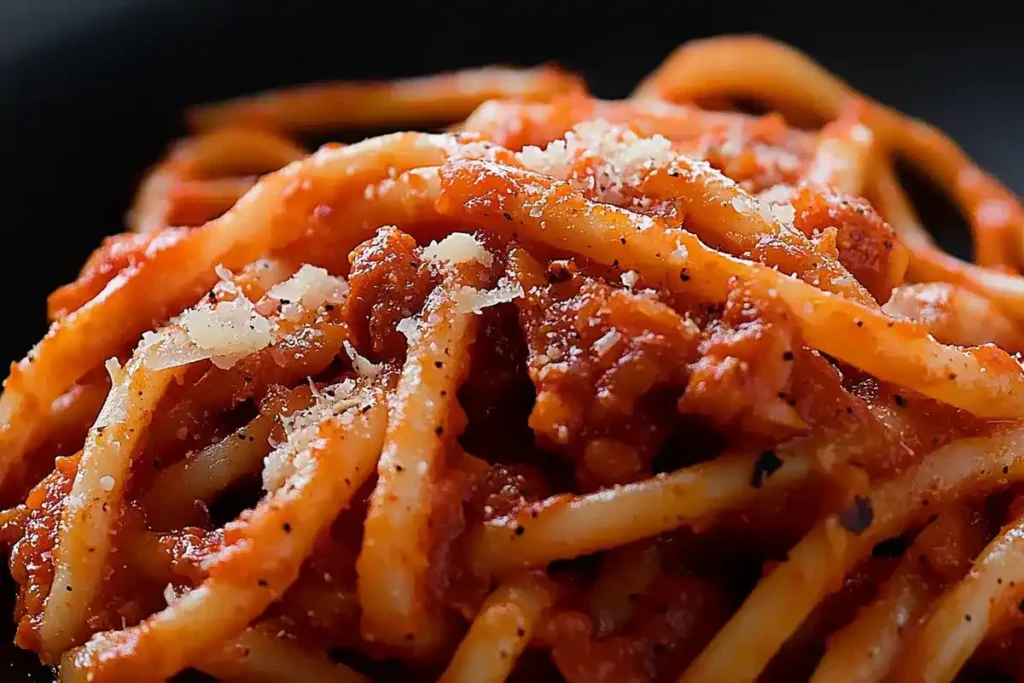
Bucatini pasta is a delicious and satisfying Italian dish known for its thick, hollow noodles and bold, savory flavors. This Bucatini Recipe combines a flavorful tomato sauce with rich garlic, olive oil, and a hint of chili flakes, making it an irresistible choice for pasta lovers. Let’s explore how to make the perfect Bucatini Recipe, from selecting quality ingredients to mastering cooking techniques, so you can bring a taste of Italy to your own kitchen.
Ingredients for Bucatini Pasta
Essential Ingredients and Their Role
To create a classic, flavorful Bucatini Recipe, you’ll need these essential ingredients:
- Bucatini Pasta: Known for its thick, tube-like shape, bucatini captures sauce perfectly. Its texture and shape provide a unique, chewy bite, which makes it perfect for this dish.
- Tomatoes: Use high-quality canned tomatoes or fresh Roma tomatoes for a rich and tangy sauce. San Marzano tomatoes are ideal for an authentic Italian flavor.
- Garlic: Essential for a rich, aromatic sauce, garlic adds depth and warmth.
- Olive Oil: Extra virgin olive oil provides the base of the sauce, adding richness and enhancing flavor.
- Red Pepper Flakes: A pinch of red pepper flakes adds a gentle heat that complements the other ingredients without overpowering the dish.
- Onion: Finely diced onion builds the base flavor of the sauce, balancing the acidity of the tomatoes.
- Basil and Parsley: Fresh herbs like basil and parsley add freshness and brightness, making the dish more complex and fragrant.
- Parmesan Cheese: Freshly grated Parmesan cheese adds a creamy, salty element that brings everything together.
Substitutions and Variations
Customize your Bucatini Recipe with these substitutions and variations:
- Alternative Pastas: If you can’t find bucatini, substitute with spaghetti or fettuccine. However, the hollow center of bucatini truly elevates this dish, so it’s worth finding!
- Meat Additions: For added protein, include Italian sausage, pancetta, or a plant-based meat substitute. Sautéed until golden, these will add richness to the sauce.
- Vegetables: Additions like spinach, zucchini, or mushrooms can increase the nutritional content and add more texture to the sauce.
- Vegan Option: To make this recipe vegan, skip the Parmesan cheese or use a plant-based alternative.

Where to Source Fresh Ingredients
For the best results, sourcing fresh, quality ingredients is key in any Bucatini Recipe:
- Pasta: Buy from a reputable grocery store or Italian market. Look for authentic Italian brands to capture the traditional taste and texture.
- Tomatoes: Use high-quality canned tomatoes from a trusted brand like San Marzano for the best flavor and color.
- Olive Oil: Cold-pressed extra virgin olive oil will give the sauce a richer, more nuanced taste.
- Cheese: If possible, use freshly grated Parmesan cheese from a block for the best flavor.
Step-by-Step Guide to Preparing Bucatini Pasta
Preparing the Sauce
- Sauté the Aromatics: Start by heating a generous drizzle of olive oil in a large skillet over medium heat. Add diced onions and cook until they’re soft and translucent, about 5 minutes. Add minced garlic and red pepper flakes, and cook for another minute until the garlic is fragrant.
- Add Tomatoes: Pour in the canned tomatoes, breaking them up with a spoon. Season with salt and pepper to taste. Let the sauce simmer gently, stirring occasionally, for 20-25 minutes. This will allow the flavors to meld and the sauce to thicken.
- Adjust Seasoning: Taste the sauce and adjust the salt, pepper, or red pepper flakes as needed. If you prefer a slightly sweeter sauce, add a pinch of sugar to balance the acidity of the tomatoes.
- Finish with Herbs: When the sauce has thickened to your liking, stir in freshly chopped basil and parsley. Remove the skillet from heat and set it aside while you cook the pasta.
Cooking the Bucatini Pasta to Perfection
- Boil the Water: Bring a large pot of salted water to a boil. Use about 1 tablespoon of salt per 4-5 cups of water; the salty water enhances the pasta’s flavor.
- Cook the Bucatini: Add the bucatini to the boiling water and cook until it reaches al dente, about 9-11 minutes (check the package instructions as well). Stir the pasta occasionally to prevent it from sticking together.
- Reserve Pasta Water: Before draining the pasta, save about a cup of the starchy pasta water. This will help thicken the sauce and ensure it adheres to the pasta.
- Drain the Pasta: Once the bucatini is cooked to al dente, drain it in a colander. If you’re not ready to combine it with the sauce immediately, toss the pasta with a bit of olive oil to prevent it from sticking.
Combining the Bucatini and Sauce
- Add Pasta to Sauce: Transfer the cooked bucatini to the skillet with the tomato sauce. Toss gently to coat the pasta evenly in the sauce.
- Adjust Consistency: If the sauce seems too thick, add a bit of the reserved pasta water, a tablespoon at a time, until the sauce reaches the desired consistency.
- Add Cheese and Serve: Sprinkle freshly grated Parmesan cheese over the pasta, giving it a final toss. Garnish with more basil or parsley if desired, and serve immediately.
Tips for the Perfect Bucatini Recipe
Balancing Flavors
Achieving the perfect balance of flavors is key to making an unforgettable Bucatini Recipe:
- Season Generously: Since the dish relies on simple ingredients, seasoning is essential. Salt the pasta water and taste the sauce as it simmers to ensure a well-balanced flavor.
- Herb Freshness: Use fresh herbs, especially basil and parsley, for a more fragrant and robust flavor. Dried herbs can work in a pinch, but they won’t provide the same vibrant taste.
- Acidity and Sweetness: The natural acidity of the tomatoes can be balanced with a small pinch of sugar, but use this sparingly to avoid an overly sweet sauce.
Achieving the Perfect Texture
The texture of both the pasta and the sauce contributes to the overall enjoyment of the dish:
- Pasta Texture: Cook the bucatini until al dente; it should be tender but still firm. The hollow shape of bucatini captures the sauce beautifully, enhancing each bite.
- Sauce Consistency: The sauce should be thick enough to cling to the pasta but not too heavy. Adding a splash of reserved pasta water can help achieve the perfect sauce consistency.
Enhancing the Dish with Additional Ingredients
For added depth and variety, consider these ingredients:
- Chili Oil: Drizzle a bit of chili oil over the finished dish for an extra kick.
- Anchovy Paste: Just a small amount can add a savory umami depth to the sauce.
- Capers or Olives: These can add a briny, Mediterranean flavor, perfect for those who enjoy more complex tastes.
Pairing Suggestions for Bucatini
Best Wines to Pair with Bucatini
Pairing the right wine with a Bucatini Recipe enhances the dining experience:
- Red Wine: A medium-bodied red wine like Chianti or Sangiovese complements the rich tomato sauce and pasta. The acidity of these wines balances the dish’s flavors well.
- White Wine: A crisp white wine like Pinot Grigio or Sauvignon Blanc offers a refreshing contrast to the savory sauce.
- Rosé: A dry rosé is another great option, adding a light and fruity note that pairs wonderfully with the tomatoes and herbs.
Side Dishes That Complement Bucatini
Complete your Bucatini Recipe with these side dishes:
- Green Salad: A fresh green salad with arugula, mixed greens, or radicchio adds a crisp contrast to the pasta. A simple vinaigrette works best.
- Garlic Bread: Continue the Italian theme with garlic bread, perfect for sopping up any extra sauce.
- Roasted Vegetables: Roasted zucchini, bell peppers, or cherry tomatoes make a healthy, flavorful side that complements the pasta.
Serving Suggestions for a Complete Meal
To make this a memorable meal, consider these serving ideas:
- Appetizers: Start with antipasto platters, such as marinated olives, prosciutto, or bruschetta, for a true Italian experience.
- Dessert: End the meal with a light dessert like tiramisu or a simple lemon sorbet to cleanse the palate.
Nutritional Information
Calories and Macronutrient Breakdown
Here’s a general breakdown of the nutritional content for Bucatini Recipe:
- Calories: A typical serving of Bucatini with tomato sauce contains around 450-500 calories, depending on portion size and added ingredients.
- Protein: The pasta and Parmesan cheese contribute around 15-20 grams of protein per serving.
- Carbohydrates: Bucatini pasta provides around 70-80 grams of carbohydrates, making it a satisfying meal.
- Fat: Olive oil and Parmesan cheese add about 15-20 grams of healthy fats to the dish.
Health Benefits of Key Ingredients
Bucatini offers several health benefits thanks to its key ingredients:
- Olive Oil: Extra virgin olive oil is a great source of monounsaturated fats and antioxidants, supporting heart health.
- Garlic and Tomatoes: Garlic has immune-boosting properties, while tomatoes are rich in vitamin C and antioxidants like lycopene, which benefits skin and heart health.
- Herbs: Fresh herbs not only enhance flavor but also add vitamins and minerals.
Adjusting the Recipe for Dietary Needs
To accommodate different dietary needs, consider these adjustments:
- Gluten-Free: Substitute traditional bucatini with a gluten-free version made from rice, quinoa, or chickpea flour.
- Low-Carb: Swap bucatini with zucchini noodles or shirataki noodles for a low-carb option.
- Vegan: Skip the Parmesan cheese or use a vegan cheese alternative for a completely vegan dish.
Frequently Asked Questions
Can I Use Fresh Tomatoes Instead of Canned?
Yes, you can use fresh Roma tomatoes if you prefer. Blanch them in boiling water, remove the skins, and dice before adding them to the sauce. Fresh tomatoes provide a lighter, fresher flavor but may require longer cooking to break down.
How Can I Make This Dish Spicier?
To make the dish spicier, increase the amount of red pepper flakes or add a splash of chili oil to the sauce. You can also serve it with Calabrian chili paste on the side.
What Are the Best Types of Cheese to Use?
Freshly grated Parmesan cheese is traditional, but Pecorino Romano or Grana Padano can also add a delicious flavor. Each cheese has a slightly different taste profile, so choose one based on your preference.
Can I Make Bucatini Ahead of Time?
While it’s best enjoyed fresh, you can prepare the sauce in advance and store it in the refrigerator for up to three days. Reheat the sauce, then cook the bucatini just before serving for the best texture.
How Should I Store Leftovers?
Store any leftover Bucatini in an airtight container in the refrigerator for up to three days. Reheat in a skillet with a splash of water or olive oil to loosen the sauce.
Conclusion
This Bucatini Recipe is an easy yet delicious way to enjoy a hearty, traditional Italian pasta dish. The thick, hollow noodles hold the flavorful tomato sauce, garlic, and herbs beautifully, creating a rich and satisfying meal. Whether it’s a family dinner or a special occasion, this Bucatini dish is sure to impress. Try it today and experience the comforting, bold flavors of Italy in every bite!